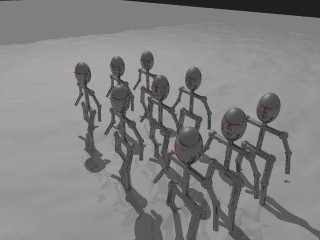The researchers say they have developed a programmed method that allows researchers to build and organize regular patterns on an unprecedented scale.

Chemists from New York University (NYU) and Nanjing University in China have developed a two-armed nanorobotic device capable of manipulating particles within another device consisting of DNA. The state-of-the-art facility was recently described in the scientific journal Nature Nanotechnology.
"The ultimate goal of nanotechnology is to place certain atomic and molecular forms where we want them and when we want them," said chemistry professor Nadrian Seeman, one of the authors of the paper. "This is a programmed method that allows researchers to construct and organize regular patterns on a scale that is unprecedented."
The device is 150 x 50 x 8 nm in size. A nanometer (or millimicron) is equal to one billionth of a meter or 10-9 meters. The new device was developed as an extension of earlier work by researcher Seeman - a single nanorobotic arm prepared in 2006 and marking the first point in time when scientists were able to use a functional nanotechnological device within an array of DNA.
The new two-armed device uses DNA origami. - a method that was revealed in 2006 and uses hundreds of DNA strands. short to direct a DNA strand. Very long for creating structures that adapt to themselves any shape we want. These structures, whose diameter is about one hundred nanometers, are eight times longer and three times more complex than the structures obtained from a DNA array. normal crystals.
Similar to the researcher's previous discovery, the two-armed nano-robotic device enables the creation of DNA structures. New, and as a result it could be used as a "factory-builder" for the organization of basic structural units of modern materials. With this ability, the development of modern synthetic fibers will be possible, the coding of information will be promoted and the computerized organization of structures based on DNA-scaffolds will be improved.
In the state-of-the-art facility, the arms face each other, similar to tweezers, and are ready to capture particles that make up the DNA sequence. Using pre-fixed strands attached to their ferrule, the arms are now able to change the shape of the device. This change results in the availability of sticky ends to recapture additional structural components.
The researchers note that the facility functions with XNUMX percent accuracy. Previous attempts have shown that it is only able to capture target foals sixty to eighty percent of the time. However, by heating the device in the presence of unique materials, the researchers discovered that the arms capture the target's prey XNUMX percent of the time. These findings were verified using an atomic force microscope (AFM), which allows viewing nanometer details.

7 תגובות
It's a shame they didn't publish the output image of the AFM
Sounds fascinating
exciting! But it seems to me that some information is missing here, how exactly is the control of the arms carried out? How do you set them up and what to build? Let's say you want to arrange a group of atoms in a hexagonal shape, how do you do it practically? I really didn't understand it from what was said.
Waiting for the first molecular computer...
I actually feel that the whole matter of nano robots is progressing at an incredible pace
It seems that after computerization this is going to be the next breakthrough in the world
There is a feeling that it will take quite some time (dozens of years) until these kinds of discoveries are reflected in the common man.
Awesome, thanks for the article.
This will be an important step, I think, also in the production of drugs on a genetic basis where it will be possible to actually engineer genes that we want to be implanted individually and in commercial quantities.